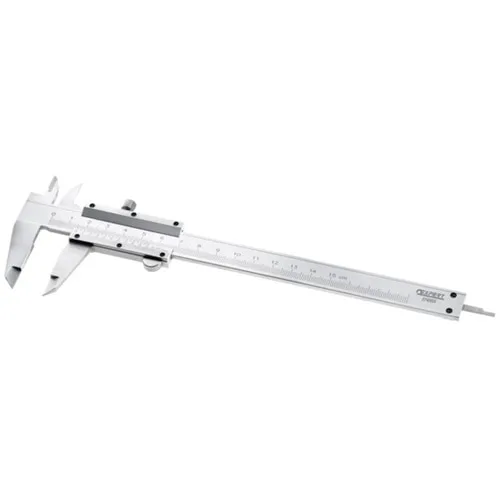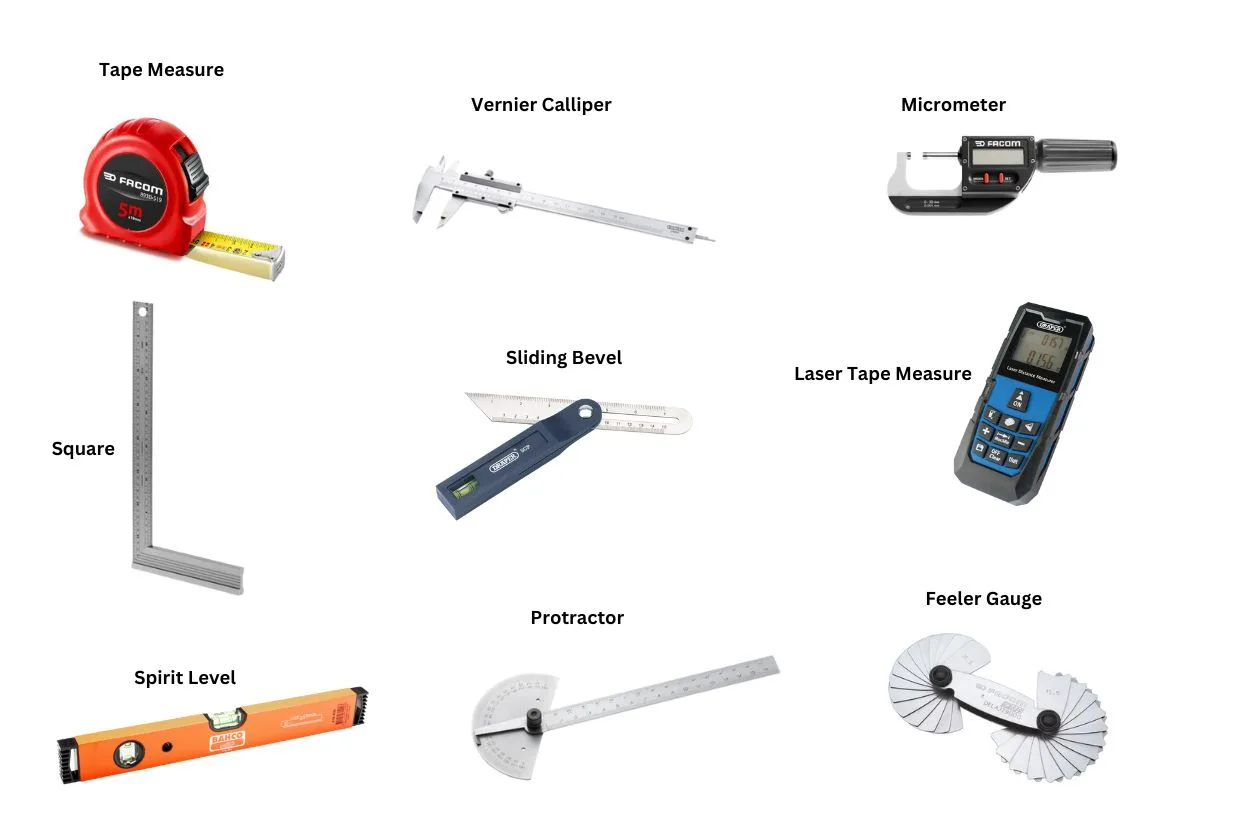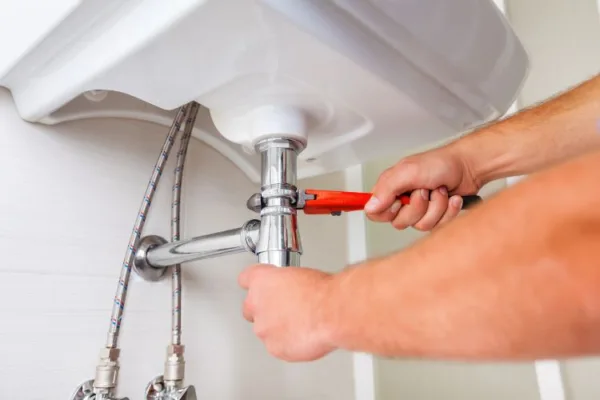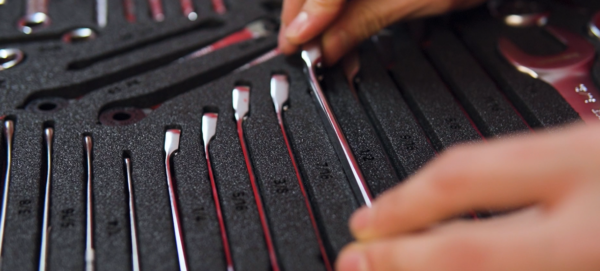What are measuring tools?
Workshop measuring tools help you to accurately measure angles, record an object’s exact dimensions, or discern the distance between two or more points.
As tool families go, measuring tools are a diverse tool group, spanning a variety of styles and applications. These range from basic measuring tools such as the tape measure and spirit level to more technical tools such as the vernier calliper.
As with all tools, the key to using measuring tools correctly is by choosing the right tool for the job. So, to help in your selection, we’ve shortlisted 9 must-have measuring tools for your workshop, explaining how each tool works and its main uses.
Types of measuring tools and their uses
1. Tape measures
Featuring a hooked end, attached to an extendable ruler that retracts and coils, tape measures range from 5m to 100m in length and are one of the most common measuring tool types.
They come in a few different styles, from spring-loaded tape measures that automatically retract to non-retractable tape measures that you retract using a hand crank. A third type of tape measure is the Surveyor’s Tape Measure. These measure extremely long distances and feature a spiked ground hook to hold them steady.
Tape measures also come in three different accuracy ratings, of which class 1 is the most accurate and best suited to professional applications.

2. Spirit Levels
Spirit levels are another well-known measuring tool. Used to indicate when a surface is vertically or horizontally level, they feature a liquid vial with a visible air bubble inside that, when level, sits perfectly centred within two marked lines.
Like tape measures, spirit levels come in different types. These range from Box Beam Levels, discernible by their rectangular shape, to post levels, a two-sided spirit level used for measuring the angle of fence posts. The other two types of spirit levels are Scaffold Levels, used during the erection of scaffolding, and Torpedo Levels, a three-vial level used to determine vertical, horizontal, and 45° angles.
Large spirit levels average around 1830mm in length while the smallest are just 65mm in size. Accuracy-wise, you should aim for a measurement of plus or minus 0.5mm per metre or 0.029° to ensure the most trustworthy results.

3. Sliding Bevels
A sliding bevel (also known as a bevel gauge, T-bevel or bevel square) will be familiar to anyone working in carpentry. Composed of two parts – a stock and a beam – both of which can tilt on an axis, a sliding bevel is one of the best tools for accurately marking up angles.
Its adjustable parts can be tilted and locked to any angle, as well as extended or shortened to differing lengths. Simple, but extremely versatile in design, it’s a must-have workshop measuring tool for accurately translating architectural measurements or drawings onto raw materials.

4. Squares and Rulers
While squares allow you to accurately gauge the angle between two surfaces, rulers are a simple tool you can use to measure the distance between two points or to draw a perfectly straight line.
Rulers, like those you will remember from school, are available in lengths of 15cm to 1m and are typically made from metal, wood, or plastic. Like tape measures, rulers have an accuracy classification of 1, 2, or 3, with class 1 rulers being the most accurate.
Squares come in a range of styles, one of the most popular of which is the ‘L-shaped’ Framing Square used by carpenters and furniture makers. Combination Squares are often identifiable by their in-built spirit level, while Try Squares feature a wooden handle and thin metallic blade. T-squares resemble the letter ‘T’ and are mainly used for drywall installation, and Rafter Squares (sometimes referred to as Speed Squares) have three angular sides in the shape of a triangle. This square type assists with the placement of rafters (thus their name).

5. Protractors
Like Sliding Bevels, Protractors allow you to accurately transfer angle markings from drawings to raw materials. Usually made of plastic, they resemble a ‘D-shape’ in that they have a ruler-like flat edge on one side and a semi-circle on the opposite side.
Protractors are additionally fitted with a moving sliding scale that the user manually adjusts to the exact degree to achieve the desired gradient.

6. Micrometers
A Micrometer is used to measure the diameter and girth of small objects up to 25mm, such as pipes or coins. It has an almost vice-like appearance, with its main components consisting of an adjustable spindle, an anvil, and a C-shaped frame.
Micrometers have an incredible accuracy of plus/minus 0.004mm and are most common in industries such as plumbing and engineering.

7. Feeler Gauges
A Feeler Gauge is a tool you use to measure widths between objects that are near to one another. Able to ease into tight spaces that other measuring tools struggle to penetrate, Feeler Gauges are popular with tradespeople such as mechanics.
Unlike most types of measuring tools, Feeler Gauges are fitted with small steel lengths (referred to as blades) in different thicknesses. These blades are then inserted into gaps to provide an estimate as to the diameter of the opening.

8. Vernier Callipers
A Vernier Calliper can help you to accurately measure internal and external voids as well as depths. Mainly used in metalwork and carpentry, this rod-shaped tool is fitted with two jaws, one large and one small, which measure the outer and internal proportions respectively. Depth is gauged separately by a depth probe attachment.
You can generally find both digital and analogue versions of Vernier Callipers. While digital Vernier Callipers provide automated readings, analogue varieties need to be manually read by the user.

9. Laser Measures
Also referred to as Laser Tape Measures, Laser Measures use a laser light beam to calculate distance and volume. Measurements are determined by how long it takes the beam to return, and the results are displayed on a digital screen.
Used frequently by landscapers, plumbers, surveyors, and electricians, Laser Measures are one of the most reliable tools for measuring distance, with the most accurate models able to give a result of within 1.5mm. Ranges vary from 15m (ideal for indoor use) to 80m – perfect for long-range applications.

Factors to Consider When Buying Measuring Tools
With such a wide variety of measuring tool types available, some better suited to different applications, the most important thing to consider when buying measuring tools is what you need the tool to do. This will immediately rule out some types of tools and shift your focus onto those best suited to the job at hand.
Once you’ve established the type of measurements you need to collect, consider where you will be working. Are you likely to be permanently based in a workshop or moving from location to location? The answer to this question will impact not only the types of measuring tool you choose to buy but also the tool storage you need to protect them.
Finally, consider how accurate you need the results to be. Measuring tools come in different degrees of accuracy, often reflected in their price. If you’re only using your tools casually, say for home DIY, being 98.9% accurate might suffice. If you’re a professional carpenter on the other hand, laser accuracy is likely to be paramount.
How to Properly Store and Maintain Measuring Tools
The best way to store and maintain measuring tools is with purpose-designed tool storage, ideally something hardstanding and watertight, fitted with custom foam inserts.
Cleaning your tools regularly will also help to remove grease, dirt, and other residue that if left alone could impact your tools’ integrity.
Spaying metal tools with WD-40 is another good tool maintenance habit you should get into. This, along with drying your tools before storing them, will go a long way in helping to protect your tools from rust and corrosion.
Popular Measuring Tools
Ready to improve the accuracy of your measuring?
Shop our top-rated measuring tools and take your workmanship to the next level. Find your perfect match from our 9 must-have measuring tool types or discover our other measuring tool ranges, including a measuring wheel, angle finder, and marking tools.
Ready to get organised?
Find your perfect tool storage from our professional range
From tool bags and tool chests to tool boxes with wheels, tool belts, tool cases, and trade-specific tool storage, at Red Box Tools we offer high-quality solutions you can count on.
Or why not take your tool storage to the next level with our made-to-order tool box foam drawer inserts and custom shadow foaming?











































